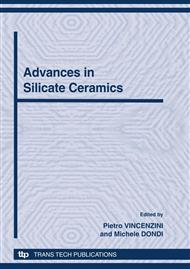[1]
Development Bank's of Turkey Inc. in: Researches of Industry edited by Research Center, Ankara/Turkey (2005).
Google Scholar
[2]
R. Hopper, in : The Ceramic Spectrum, edited by Chilton Book Company, Radnor, Pennsylvania, (1984), p.124–125.
Google Scholar
[3]
R.A. Eppler, D.R. Eppler, : Glazes and Glass Coatings, submitted to Am. Ceram. Soc., Westerville, Ohio, (1998), p.113–130.
Google Scholar
[4]
N. Ay, M. Çakı, in : Investigations on the Usability of Fly-ashes in the Coloring of Glazes, edited by International Ceramic Congress Proceedings Book, Eskisehir/Turkey, (1992).
Google Scholar
[5]
F. Bondioli, L. Barbieri, T, Manfredini, : Grey Pigment (Fe, Zn)Cr2O4 Obtained from Industrial Fly-Ash submitted to Tile&Brick Int., Vol. 16, (2000), pp.246-248.
Google Scholar
[6]
N. Ay, M. Çakı, in: Utilization of Pigments Obtained from Fly Ash in Coloration of Ceramic Glaze', (Poster Presentation), submitted to Conference Exhibition of the European Ceramic Socities , Turkey, (2003).
Google Scholar
[7]
S.A. Chronisher, W. Chen, in: Using Lead-Free Glaze with Chrome-Tin Color Under glaze, submitted to The Am. Ceram. Soc. Bulletin, Vol. 73, (1994).
Google Scholar
[8]
N. Ay, M. Çakı, in: Effect of Fe2O3 and Cr2O3 on Colour Development, submitted to IV. Ceramic Congress Proceedings Book, Eskisehir/Turkey, (1998).
Google Scholar
[9]
F. Ren, S. Ishida, N. Takeuchi, K. Fujiyoshi, in: Chromium-Based Ceramic Colors, submitted to The Am. Ceram. Soc. Bulletin, Vol. 71, (1992).
Google Scholar
[10]
C.J. Byrne, S.G. Kutney, R.A. Pipoly, in: How Glaze Composition Affects Chrome-Tin Pinks, submitted to The Am. Ceram. Soc. Bulletin, Vol. 73, (1994).
Google Scholar
[11]
N. Ay, M. Çakı, in: The usage of Chromite as a Colorant in Stoneware Glazes, submitted to V. Ceramic Congress Proceeding Book, Istanbul/Turkey, (2001).
Google Scholar
[12]
N. Ay, M. Çakı, A. Kara, in: Ferrochromium Fly Ash Used as a Pigment in Ceramic Glaze, submitted to The Am. Ceram. Soc. Bulletin, Vol. 73, (1994).
Google Scholar
[13]
M. Çakı, in: The Usability of Ceramic Colors and Chromite as a Colorant, Technical University of Istanbul, Graduate School of Sciences, (1986).
Google Scholar
[14]
Information on http: /www. etimet. com/dkferrokrom. htm.
Google Scholar
[15]
R.A. Eppler, D.R. Eppler, in: Which Colors can and cannot be Produced in Ceramic Glazes, submitted to Ceram. Eng. Sci. Proc., Vol. 15.
Google Scholar
[16]
R.A. Eppler, D.R. Eppler, The interaction Of Ceramic Pigments with Glazes, submitted to Ceramic Bulletin , Vol. 68, (1989).
Google Scholar
[17]
E. Ozel, S. Turan, 'Production and Characterization of Iron-chromium Pigments and Their Interactions with Transparent Glaze, submitted to Journal of European Ceramic Society 23, (2003).
DOI: 10.1016/s0955-2219(03)00036-0
Google Scholar
[18]
F. Bondioli, L. Barbieri, T. Manfredini, Grey Ceramic pigment (Fe, Zn)Cr2O4 obtained from industrial fly-ash, submitted to Tile & Brick Int., Vol. 16, (2000).
Google Scholar


